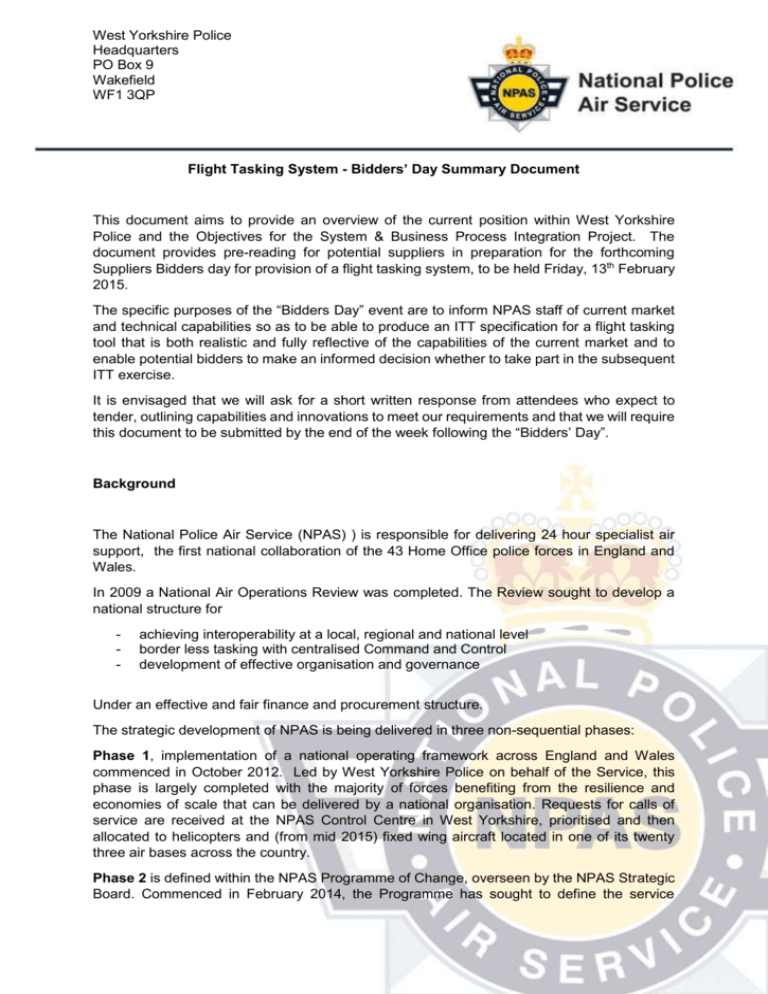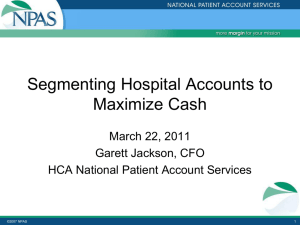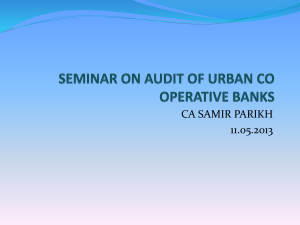NPAS Tasking System Bidders Day - Pre-event
advertisement

West Yorkshire Police Headquarters PO Box 9 Wakefield WF1 3QP Flight Tasking System - Bidders’ Day Summary Document This document aims to provide an overview of the current position within West Yorkshire Police and the Objectives for the System & Business Process Integration Project. The document provides pre-reading for potential suppliers in preparation for the forthcoming Suppliers Bidders day for provision of a flight tasking system, to be held Friday, 13th February 2015. The specific purposes of the “Bidders Day” event are to inform NPAS staff of current market and technical capabilities so as to be able to produce an ITT specification for a flight tasking tool that is both realistic and fully reflective of the capabilities of the current market and to enable potential bidders to make an informed decision whether to take part in the subsequent ITT exercise. It is envisaged that we will ask for a short written response from attendees who expect to tender, outlining capabilities and innovations to meet our requirements and that we will require this document to be submitted by the end of the week following the “Bidders’ Day”. Background The National Police Air Service (NPAS) ) is responsible for delivering 24 hour specialist air support, the first national collaboration of the 43 Home Office police forces in England and Wales. In 2009 a National Air Operations Review was completed. The Review sought to develop a national structure for - achieving interoperability at a local, regional and national level border less tasking with centralised Command and Control development of effective organisation and governance Under an effective and fair finance and procurement structure. The strategic development of NPAS is being delivered in three non-sequential phases: Phase 1, implementation of a national operating framework across England and Wales commenced in October 2012. Led by West Yorkshire Police on behalf of the Service, this phase is largely completed with the majority of forces benefiting from the resilience and economies of scale that can be delivered by a national organisation. Requests for calls of service are received at the NPAS Control Centre in West Yorkshire, prioritised and then allocated to helicopters and (from mid 2015) fixed wing aircraft located in one of its twenty three air bases across the country. Phase 2 is defined within the NPAS Programme of Change, overseen by the NPAS Strategic Board. Commenced in February 2014, the Programme has sought to define the service required from NPAS and consider how to revise its current operating model to meet the financial challenges ahead whilst maximising service at a local, regional and national level. Phase 3- NPAS is currently working with other agencies and services to build more effective inter-operability and deployment. Current Position As a result of the Government’s Comprehensive Spending Review (CSR) in October 2010, all police forces in England and Wales were set significant budget reductions. On average, forces are required to reduce their running costs by 20-25%. The CSR was originally scheduled to run from 2011/12 through to 2014/15. However, since then, the CSR period has been extended to 2017 and the budget reductions for police forces have also increased. To date, NPAS has achieved a 23% revenue saving against pre-inception costs and enabled operational flexibility that would have otherwise been difficult or impossible to achieve. It is acknowledged by a number of Chief Officer Teams across the country that, in the absence of NPAS, provision of localised air support would now be financially untenable. Whilst these savings are impressive, NPAS is required to achieve a further 14% revenue saving over the next three years. Whilst much of this will be achieved by developing a new operating model The contract ceases with the current supplier on 31 December 2015. NPAS are currently seeking a consultant to review and support development of its overall IT strategy. The Flight Tasking System must be mindful of the outcomes that NPAS aspire to in this area: Office systems Use will be wireless, enabling staff to work on tablets/platforms within bases, aircraft and other locations. This may be on personal issue equipment or shared solutions The network will enable NPAS employees to go to any bases country wide and utilise systems owned and operated by WYP The solution will not rely on ‘traditional’ permissions and systems owned by the current 43 Home Office Forces and local IT systems. It will enable fast and reliable access within an NPAS network. Options will consider a range of solutions from a full stand-alone network to WYP operated. The support of the system must also be innovative and cannot rely solely on technical support from WYP based personnel That the system is clearly defined as an NPAS product, allowing future consideration of transfer from WYP infrastructure or recharging of services if WYP remain as a commissioned service Communication That a visual reliable, secure high quality contact/communication medium is established across the NPAS base network and HQ function minimising the requirement for road/air travel. This may include a blend of solutions which enable peer to peer and multiple conference facilities That access to a virtual network is not reliant on ‘traditional’ permissions and systems owned by the current 43 Home Office Forces and local IT systems. That police forces will be able to request NPAS services via a web portal that links to the NPAS Operations Centre. This will be automated with minimal handovers The new Flight Tasking System will play a central role in delivering more effective management of service provision, aircraft and personnel. Traditionally Force are enabled departments to procure systems that meet their functional needs most effectively. The current system evolved from purchases made in isolation for the various Air Support Units operated by forces ‘pre-NPAS.’ This is now configured in a peer-topeer format that synchronises all records, including tasking requests between all units. This approach has proved challenging, with significant investments in time for NPAS personnel, local IT leads and WYP infrastructure staff. There are a significant number of business processes that are dealt with either through systems that are not fully integrated and therefore generate re-work or are completed through paper-based applications. NPAS would like to develop a System that is lean, reducing unnecessary administrative overhead and improving user satisfaction. Functional Requirements of the Flight Tasking System Any prospective system would be hosted on the West Yorkshire Police’s server infrastructure to avoid additional costs in replacing systems: However, the Force would be open to considering alternative solutions where a significant contribution towards delivering the CSR cost reduction target can be evidenced. Any cloud or off premise solution should be appropriately assured from a data integrity and information assurance perspective. The System will be hosted as a minimum on a clustered pair of Windows 2012 servers located at two Force data centres with replication across the database allowing updating to be done from both sites. Any virtualisation would be achieved through the use of VMware and this needs to be a supported platform. Ideally the system should be browser based rather than requiring a client and support Windows Internet Explorer 11 onwards. It must be able to respond to changes in processes/workflow; ability to work with current and future versions of MS Windows; the ability to change base locations etc. Access will be required - via PSN which is replacing the PNN and CJX networks 3g/4g for downloading ongoing and new incidents In the air Via a web based front end. Client devices running the system - 2Gz CPU - 80 Gb hard drive - 4 Gb RAM - Minimum of 1024 x 768 screen resolution - Windows 7, 8,8.1 - Adobe Reader (latest version) for printing - 100 mB+ Ethernet card - Internet connection Capacity and scalability requirements/ capability: You will provide details of predicted impact on WYP’s storage which is currently based on a deployment of EMC VNX for tier one, EMC ISILON for tier 2. Support and maintenance Suppliers to provide how they would address such issues as fault management, archiving of data, software maintenance etc. Implementation: Suppliers will provide details of - Their project management proposals The resource requirements Data conversion requirements Testing Training and Documentation Objectives 1. Reduce duplication of effort through the automation or removal of existing processes to reduce organisation administrative overhead- reduced business costs. NPAS has a very clear understanding and capability to deliver ‘lean’ business processes. It has already commenced this and implemented various process improvements. However, the impact is limited because the current infrastructure is not in place to implement end-to-end automated processes through our systems. This results in the creation of a partially automated processes supplemented by activities carried out manually. This position also creates a situation where secondary processes are being introduced such as locally maintained spread sheets. This is largely due to a lack of trust in the information contained in the existing system, a lack of effective workflows in some of our applications and limited integration between the systems. Our desire is to automate business processes driving down the administrative burden by reduced double keying, avoided duplication and the transfer of responsibility for process completion. Any System must support accessibility in the air, maximising single key prompting. The objective is to deliver a mechanism which will allow NPAS to successfully automate high impacting but leaner business processes to reduce the cost of the back office functions. 2. Development of an overarching self-service framework for Data Quality Management and transaction processing which provides a single point of entry to existing core systems, enabling ‘one version of the truth’ The existing strategy has delivered some efficiency opportunities for NPAS but there is an opportunity for the System to provide more effective interface into current systems including G’Cap, Tranman, Steria Storm, CARM and mapping software. Information that is entered into these systems is not currently used to directly update other systems. NPAS wishes to ensure that end-users of the System are presented with a single point of entry to guide them to the correct landing point for the task they require to perform irrespective of the target system. NPAS accepts that there may be limitations with this desire which are dependent on individual back office systems rather than the solution being considered. 3. To achieve a common methodology for system interactions and process workflows to remove the reliance on bespoke system to system interfaces and simplify the upgrades or replacements of existing back office systems. Such methodology should provide NPAS with the ability to configure and maintain the solution including business process delivery, workflow and system administration. Where possible, the Force would desire to minimise the bespoke nature of any core transactional systems and elect to provide self-service and process automation via a tailored middleware solution. End users would be presented with a single point of entry to conduct their self-service and this would interact with the middleware to drive transaction processing, data quality management and workflow notifications. NPAS seeks a solution which will provide the ability to add and remove additional integrations, automations and self-service routines without further consultancy or development maintained by suitably knowledgeable power users within the Force. Whilst it is accepted that a degree of configuration and customisation will be required to deliver the building blocks to the final solution it is anticipated that those blocks will empower system administrators to enable them to add additional processes and/or self-service functions or replace core systems without additional supplier input. The desired solution must maximise end-user configurability to enable flexibility and longevity of the solution’s core integration and workflow components. 4. To provide comprehensive management information / business intelligence to facilitate timely and accurate decision making. The Force recognises that whilst it currently delivers information for the purpose of executive decision making, due to the independence of the back-office functions and issues over department reporting to differing timescales, there is significant room for improvement in this area. Any considered solution should have the capacity to provide easy access to the data across the integrated systems to provide reporting and audit ability across all back office data.








